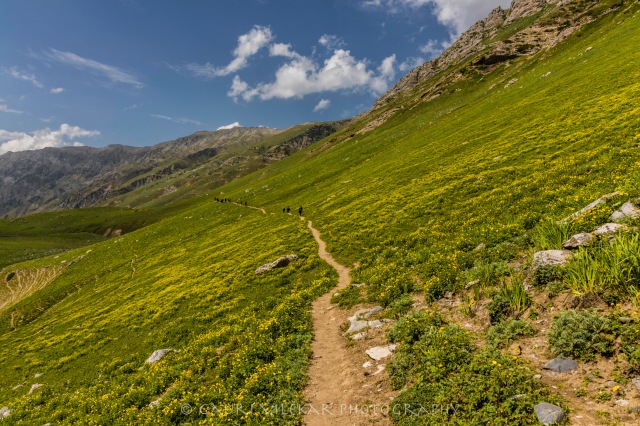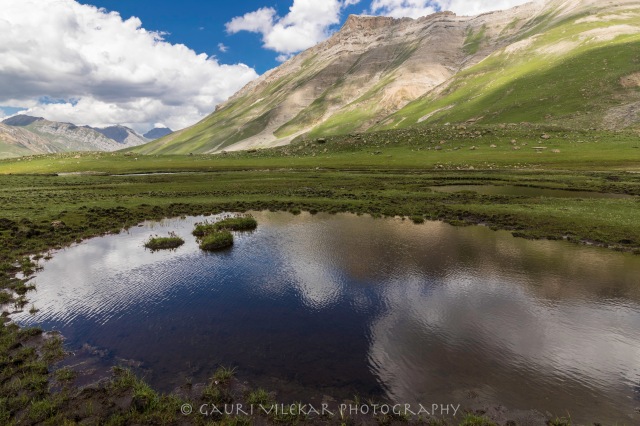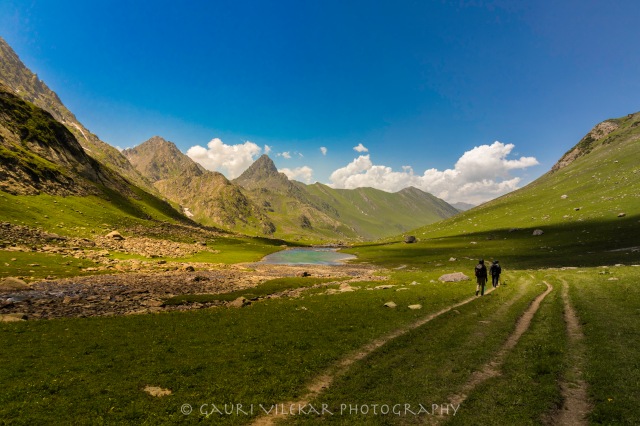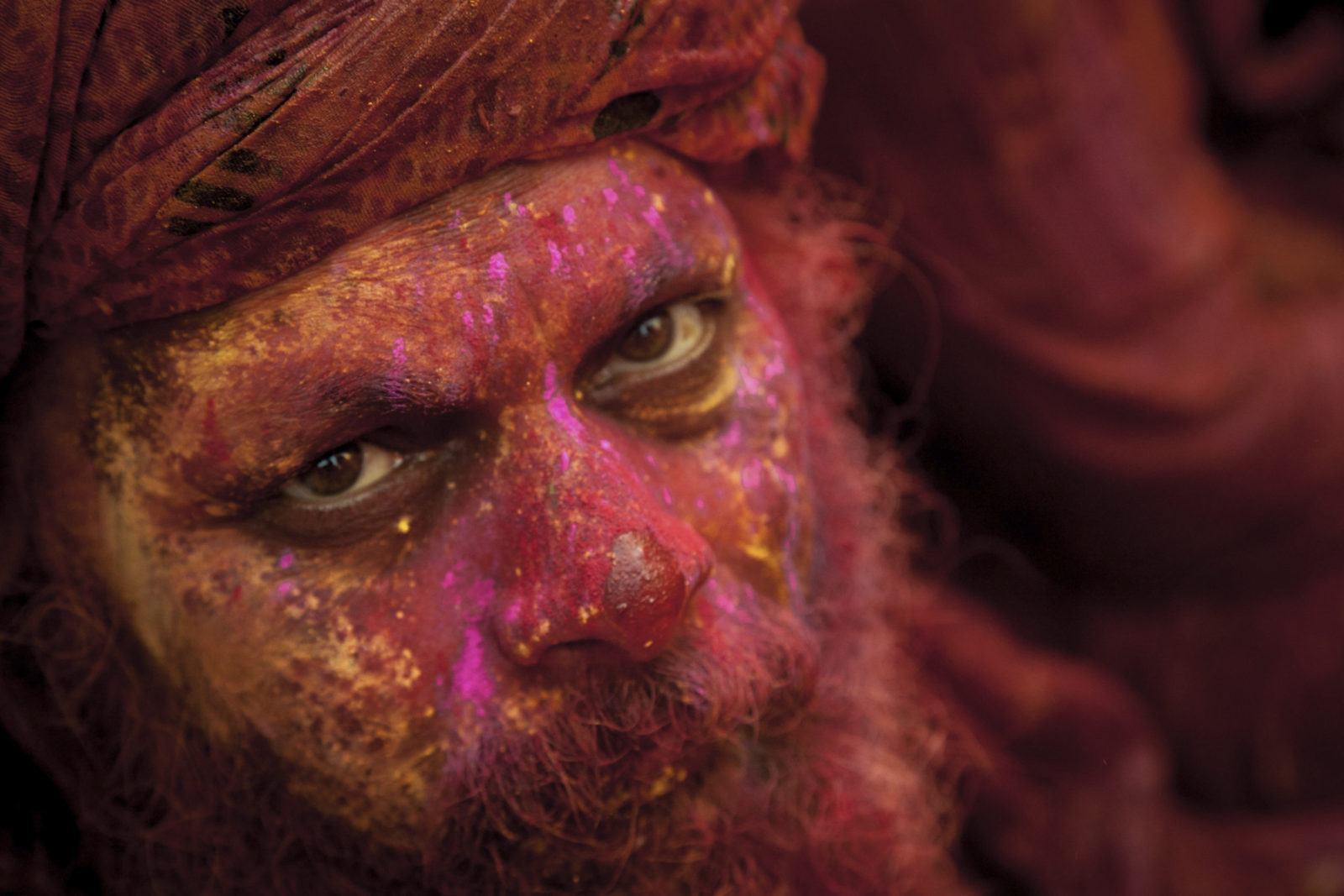
Kashmir Great Lakes was my introduction to Alpine treks. 8 days and 75 kms of trekking through breath-taking landscapes! From mountains to ridges, from meadows to pine forests, from streams to waterfalls, this one had it all! This trek unfolded six pristine, extremely picturesque, ice-fed lakes one after the other and believe me, I wasn’t able to conclude on which one was the prettiest!
Day 1: Sonmarg base camp, 9100 ft : An hour after we left the dusty town of Kangan behind, the striking views of the Himalayan foothills with tall alpine trees came into sight. We got dropped off at Sonmarg, where our vibrant tents sat on the banks of the freezing ‘Nallah Sindh’ river. Sipping on my steamy Kahwah*, I watched a Water Redstart make quick plummets into the river to fetch its evening meal. At the backdrop, the impressive Thajiwas Glacier rose calmly with fluffy white clouds drifting over it.

Day 2 : Sonmarg to Nichnai via Shekdur (7800 to 11500 ft, 11kms, 8 hours): We were a small batch of six trekkers, led by a 57-year old, age-defying guide, Gulam Mohammed, aka Gulam Chacha. The trek commenced with a gradual elevation on a mountain ridge running parallel to the river, presenting a bird’s eye view of the charming Sonmarg valley that was waking up to a hazy, silvery morning. The construction of a massive tunnel connecting Sonmarg to Leh was in full swing down below. Beyond Shekdur, the vegetation transitioned from Maple and Bhoj trees to valleys and verdant meadows scattered with brooks and streams all the way up to Nichnai pass. We reached Nichnai around 3 pm. Our campsite lay next to a calm rivulet flowing amid two wide valleys. The Thajiwas glacier was visible even from Nichnai. Herds of sheep bleated and halted curiously by our camp as they made their way down. As night fell, temperatures dropped and Nichnai got engulfed in clouds and drizzle. Thanks to the ever changing weather in the Himalayas, we were greeted by a spotless sky at the break of dawn.


Day 3 : Nichnai to Vishansar Lake (11500 to 13500 to 12000 ft, 12 kms, 7 hrs): A moderate climb to 13500 feet, then a short descend followed by a long hike on green pastures with wildflowers and shrubs took us to Vishansar. From late June through September, snow from the valleys of Kashmir recede, giving way to lush green meadows. This is when the nomad tribe called ‘Gujjars’ inhabit these valleys with hordes of sheep and cattle; pitching temporary homes as they tread along. With the advent of winter from October onwards, the weather turns harsh and hostile, thus forcing the Gujjars to retreat to the lower plains or migrate to the nearby villages for livelihood.
Vishansar lake lies hidden between mountain ranges of varying heights. I stopped to say hello to a pair of nosy marmots (large squirrels) that squeaked loudly as they watched me over from their burrows. A gentle climb of around a hundred feet bought me to the edge of the imposing Vishansar. Magenta colored Celosia flowers lined its turquoise waters that shimmered under the evening sun. I spent an hour by the lakeside. Nightfall sprinkled diamond dust over the pitch-dark sky. I was able to see every visible star of the galaxy every night for the entire duration of this trek!



Day 4 : Vishansar to Gadsar via Kishansar and Gadsar pass (12000 to 13750 ft, 14 kms, 10 hrs): With Vishansar as the base, we were to scale the towering mountain adjacent to the lofty and naked Kishansar peak, which was about 3/4th of its altitude. A long zig-zag path running from the base to the top of the mountain had an endless trail of horses and ant-like humans in fluorescent clothes drifting on it, inch by inch. The steep ascend of almost 2.5 hours and thin oxygen levels made the walk cumbersome. Half way through the climb, I halted to admire the majestic Kishansar lake resting at the base of Kishansar peak. It’s still emerald waters reflected the greenish-blue mountains like a mirror. Kishansar can render an ardent nature lover speachless!


Even before I could completely soak up what I had just seen, I was already staring at the unbelievable vistas of both Vishansar and Kishansar stacked above one another at a vertical distance of about 500 feet. Standing at the uppermost point of the trail, I realised that I had overcome the most difficult climb of the trek, but somehow, it felt utterly insignificant next to what lay in front of me..

Gadsar Lake: We continued for a few more kilometers through lush meadows, I got the first glimpse of Gadsar lake to the left, down a slope and at a considerable distance from the trail. A glacier ran down from the tall peaks surrounding the lake. Yellow and purple flowers had blossomed everywhere. There was an abandoned military camp tucked away at one corner. Camping is prohibited around Gadsar by the military (thankfully).



Day 5: Gadsar to Satsar (13750 to 12000 ft, 9 kms, 6 hours) :The trail from Gadsar to Satsar ran through plains and boulders and was relatively easy. Sat(seven) sar(lakes), as the name goes, is apparently a collection of seven lakes, however, I could locate only a handful. We reached the campsite by lunch and the rest of the day was spent in recuperating.


Day 6 : Satsar to Gangbal Twin lakes (12000 to 11500ft, 11 kms, 7 hours): I had unknowingly paced up and exerted myself on the moderate ascend to Gangbal. In the bargain, I suffered mild AMS (Acute Mountain Sickness) half way through the trek. Ghulam Chacha mentioned that the pollens released from the yellow flowers had done the trick and not the AMS. Whatever be the reason, I literally crawled my way up to the last pitstop for Gangbal with a pounding headache, disorientation and fatigue.
When I finally made it to the top, I saw two emerald lakes, Nundkol and Gangbal split by a hefty mountain range. A giant blob of white cloud floated above the lakes. The view from here was insane, almost dreamlike! It took me a few seconds to convince myself that I wasn’t hallucinating due to my AMS!

A steep descend hereon led us straight into the Gangbal base camp. The mighty Harmukh with its snow-clad peaks and glaciers stood behind the lake. (The locals worship Harmukh as the protector from venomous insects, snakes, evil and natural calamities). Gangbal was enormous; yet motionless and extremely quiet, so much so that I could hear the occasional bloop-bloop of fish swimming by its banks. A waterfall splurged out of Gangbal and later joined the stream that gushed out of Nundkol and flowed besides our campsite. At twilight, the sun rays pierced through the clouds and played an opera of shadows and light from behind Harmukh. Night called for some freshly caught trout fish smoked on a bonfire under the sparkling constellations. What a terrific day it had been!




Day 7 : Gangbal. Rest. A crisp, sunny day with cool breeze and nothing to do! I learnt the true meaning of the Italian phrase – ‘Dolce far niente’ which means ‘pleasant relaxation in carefree idleness.’ or simply put ‘the joy of doing nothing!

Day 8 : Gangbal to Naranag (11500 to 7450 ft, 15 kms, 7 hours) : It had been a spectacular journey so far, but the real test was now! After crossing the fragile wooden footbridge, we encountered one last but steep zig-zag incline running parallel to a deep valley. To its right, was a lofty mountain range behind which, lay the famous Gurez Valley with parts of it in PoK (Pak occupied Kashmir). To the left, stood the mighty Harmukh. From here on right till the base of Naranag, the trek comprised only of moderate to steep descends for five long hours, passing through stunning pine forests with the sweet woody scent of pine lingering throughout! This descend was an absolute killer on my knees and toes and the ultimate test of my patience.
I let out a long sigh of relief when I finally saw the tinned roofs of the houses of Naranag from a distance. A broad smile flashed through the sweat and tan. I had indeed lived the prettiest trek of India!

About Kashmir Great Lakes Trek
Kashmir Great lakes or KGL is considered as one of the prettiest treks of India. In 8 days and 75 kms, you uncover 6 spectacular and untouched lakes that lie hidden in the mountains and valleys of Kashmir.
Route : Sonmarg-Nichnai-Vishansar-Kishansar-Gadsar-Satsar-Gangbal-Naranag
Level : Moderate-Difficult. I wouldn’t recommend it for first timers or aged people unless you have an unmatched stamina. Guided trek recommended. I went with Renok Adventures.
Stay : All seven days in tents
Base : Srinagar
Must needed : Good trekking shoes (not sneakers), walking stick, sunscreen, warm clothes in layers, medical kit. Hydration is important. Watch out for AMS.
*Kahwah : Traditional Kashmiri milk-less tea comprising of green Kashmiri tea, saffron, cardamom, sugar and almond chips. A must try

